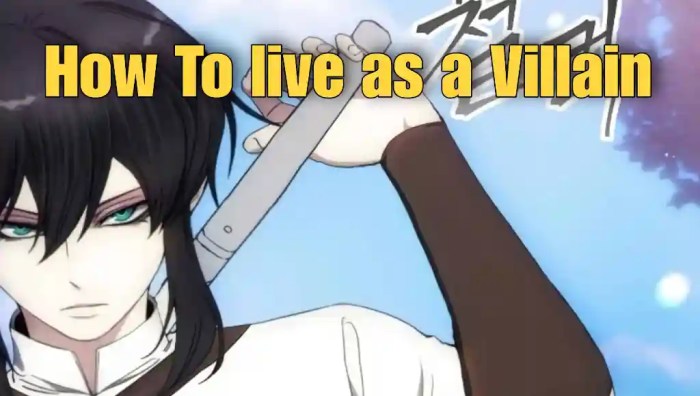
How to live as a villain ch 94 – In this exciting chapter of “How to Live as a Villain,” we delve into the intricate depths of the protagonist’s transformation. From their motivations and conflicts to the key events that shape their journey, we’ll explore the psychological complexities that drive their villainous actions.
Join us as we unravel the techniques for crafting a captivating narrative, building tension through plot twists, and creating memorable characters that advance the story. Dive into the moral dilemmas and ethical implications of the protagonist’s choices, challenging your preconceived notions of right and wrong.
Analyzing Character Development
In this chapter, we delve into the intricacies of the protagonist’s transformation into a villain, examining the motivations, conflicts, and experiences that drive their descent into darkness.
We explore the psychological and emotional complexities of their journey, shedding light on the factors that shape their choices and ultimately lead them down the path of villainy.
Motivations and Conflicts
At the heart of the protagonist’s villainous actions lie a complex web of motivations and conflicts that fuel their desire for power, revenge, or some twisted sense of justice.
We analyze the events and circumstances that have shaped their worldview, creating a fertile ground for resentment, bitterness, or a deep-seated belief in their own superiority.
Key Events and Experiences
Throughout the protagonist’s journey, we identify key events and experiences that serve as turning points in their transformation.
These moments of trauma, betrayal, or profound loss push them further into the abyss, fueling their anger and shaping their resolve to embrace villainy as a means of coping or retribution.
In the treacherous world of “How to Live as a Villain Ch 94,” the stakes are high. But even the most cunning villains can fall prey to dental woes. If you find yourself grappling with gum disease, don’t despair! While a dentist’s visit may be ideal, there are home remedies to help alleviate the pain.
Discover how to cure gum disease without a dentist and return to your villainous schemes with a healthy smile. Remember, even the most formidable villains need to take care of their pearly whites!
Psychological and Emotional Complexities
The protagonist’s journey into villainy is not merely a matter of external events but also a profound psychological and emotional transformation.
We delve into the complexities of their inner struggles, exploring the fears, insecurities, and desires that drive their actions. We examine how their perception of themselves and the world around them changes as they embrace the darkness within.
Crafting a Compelling Narrative: How To Live As A Villain Ch 94

Captivating storylines are the lifeblood of any successful novel. To craft a narrative that keeps readers engaged from start to finish, consider the following techniques:
Building Tension and Suspense
If you’re wondering how to live as a villain ch 94, I suggest you start with taking care of your health. One common problem that many people face is gum disease. If you’re looking for a way to cure gum disease without a dentist, there are some great resources available online.
This article provides some helpful tips on how to prevent and treat gum disease at home. Once you’ve taken care of your health, you can focus on your villainous pursuits in how to live as a villain ch 94.
- Introduce plot twists that challenge readers’ expectations and keep them guessing.
- Use cliffhangers at the end of chapters or scenes to leave readers eager for more.
- Create a sense of urgency by establishing stakes for your characters and the plot.
Effective Character Dialogue and Interactions
Character dialogue should not only convey information but also advance the plot and develop character relationships.
- Write dialogue that is authentic and reflects the characters’ personalities and motivations.
- Use subtext and unspoken emotions to add depth to conversations.
- Create conflicts and disagreements between characters to drive the narrative forward.
Exploring Moral Dilemmas
As the protagonist embarks on their villainous path, they are inevitably confronted with a series of ethical and moral dilemmas. Their actions have far-reaching consequences, impacting not only themselves but also those around them. The story delves into the complexities of right and wrong, challenging readers to question their own preconceived notions.
Confronting Ethical Boundaries
The protagonist’s pursuit of power and revenge often forces them to make difficult choices that blur the lines between good and evil. They must decide whether to sacrifice their own morality for the sake of their goals, or to adhere to a code of ethics that may hinder their progress.
The story explores the consequences of these choices, demonstrating how even the noblest intentions can lead to unintended harm.
Impact on Others
The protagonist’s actions have a ripple effect on the lives of others. Their pursuit of vengeance may leave innocent bystanders caught in the crossfire, while their desire for power can lead to the oppression of the weak. The story examines the moral implications of these choices, highlighting the responsibility that comes with power and the importance of considering the well-being of others.
Challenging Preconceived Notions
Through the protagonist’s journey, the story challenges readers to re-examine their own beliefs about right and wrong. By presenting a complex and morally ambiguous character, the story forces readers to confront their own prejudices and biases. It invites them to question the validity of their own moral compass and to consider the gray areas that exist between good and evil.
Creating a Memorable Villain

Crafting a memorable villain is an art form that requires a keen understanding of human nature and a knack for storytelling. A truly compelling villain is not merely evil for the sake of it but possesses a depth and complexity that makes them both terrifying and strangely charismatic.
One of the key elements of a memorable villain is their motivation. What drives them to commit heinous acts? Is it a thirst for power, a desire for revenge, or a twisted sense of justice? Understanding the villain’s motivations will help you create a character that feels real and relatable, even if their actions are despicable.
If you’re not into the whole villain thing anymore and are looking for a more wholesome approach to life, check out this guide on how to cure gum disease without a dentist . It’s got some great tips on keeping your pearly whites healthy and bright.
But if you’re still set on becoming the ultimate baddie, then be sure to catch up on chapter 94 of “How to Live as a Villain.” It’s got all the juicy details on how to scheme and conquer like a pro.
Iconic Villains, How to live as a villain ch 94
Throughout history, literature and film have given us a plethora of iconic villains who have left an unforgettable mark on popular culture. From Shakespeare’s Iago to Hannibal Lecter, these characters have fascinated and horrified audiences alike.
What makes these villains so memorable? Often, it is their combination of intelligence, charisma, and ruthlessness. They are masters of manipulation and deception, able to charm and intimidate with equal ease. They also possess a deep understanding of human psychology, which they use to their advantage to exploit the weaknesses of others.
Memorable Villain Elements
- Complexity:A memorable villain is not simply evil for the sake of it. They have a complex backstory and motivations that make them feel real and relatable.
- Intelligence:Villains are often highly intelligent and cunning. They are able to outsmart their opponents and anticipate their every move.
- Charisma:Villains can be charming and charismatic, even when they are committing heinous acts. They have a way of drawing people in and making them believe in their cause.
- Ruthlessness:Villains are willing to do whatever it takes to achieve their goals, no matter how cruel or heartless.
- Iconic Appearance:A memorable villain often has a distinctive appearance that sets them apart from the crowd. This could be anything from a unique costume to a physical deformity.
Creating a memorable villain is a challenging but rewarding task. By following these tips, you can create a character that will stay with your readers or viewers long after the story is over.
Building a World of Intrigue
Crafting a compelling villainous tale demands an immersive and believable setting. Worldbuilding plays a pivotal role in establishing the atmosphere and tone of your narrative, shaping the reader’s perception of your villain’s actions.
Designing an Immersive Setting
-
-*Sensory Details
Engage the reader’s senses by vividly describing the sights, sounds, smells, tastes, and textures of your world.
-*Historical and Cultural Context
Ground your setting in a rich tapestry of history, culture, and societal norms.
-*Unique Geography
Create a distinct and memorable landscape with unique geographical features, such as hidden passages, ancient ruins, or treacherous terrains.
Worldbuilding and Atmosphere
-
-*Atmosphere
Use worldbuilding to convey the emotional ambiance of your setting. Dark and shadowy environments can evoke mystery and suspense, while vibrant and bustling cities create a sense of chaos and intrigue.
-*Tone
Worldbuilding can set the overall tone of your narrative. A gritty and unforgiving setting will reinforce a darker and more sinister tone, while a more whimsical or fantastical setting can lighten the mood.
Effective Worldbuilding Techniques
-
-*Consistency
Maintain consistency throughout your worldbuilding to avoid confusing the reader.
-*Details
Layer your world with intricate details that add depth and realism.
-*Mystery
Leave some elements of your world unexplained to create intrigue and encourage reader engagement.
-*Interconnectedness
Connect different aspects of your world to create a cohesive and believable ecosystem.
-*Inspiration
Draw inspiration from real-world locations, historical events, or mythological tales to enhance the authenticity of your setting.
Ending Remarks

As we reach the end of this chapter, we’ve gained a deeper understanding of the villain’s journey. We’ve learned the importance of worldbuilding in creating a believable setting and the elements that make a villain both charismatic and terrifying. With this knowledge, you’re well-equipped to continue your exploration of the villain’s path and create your own unforgettable characters.
Commonly Asked Questions
What are the key motivations driving the protagonist’s villainous actions?
The protagonist’s motivations can range from personal grievances and a desire for revenge to a twisted sense of justice or a belief in a greater cause.
How do the key events shape the protagonist’s transformation into a villain?
Traumatic experiences, betrayal, or exposure to darkness can all contribute to the protagonist’s descent into villainy.
What are some effective techniques for creating a captivating storyline?
Using plot twists, building tension, and creating suspenseful cliffhangers are all effective ways to keep readers engaged.





